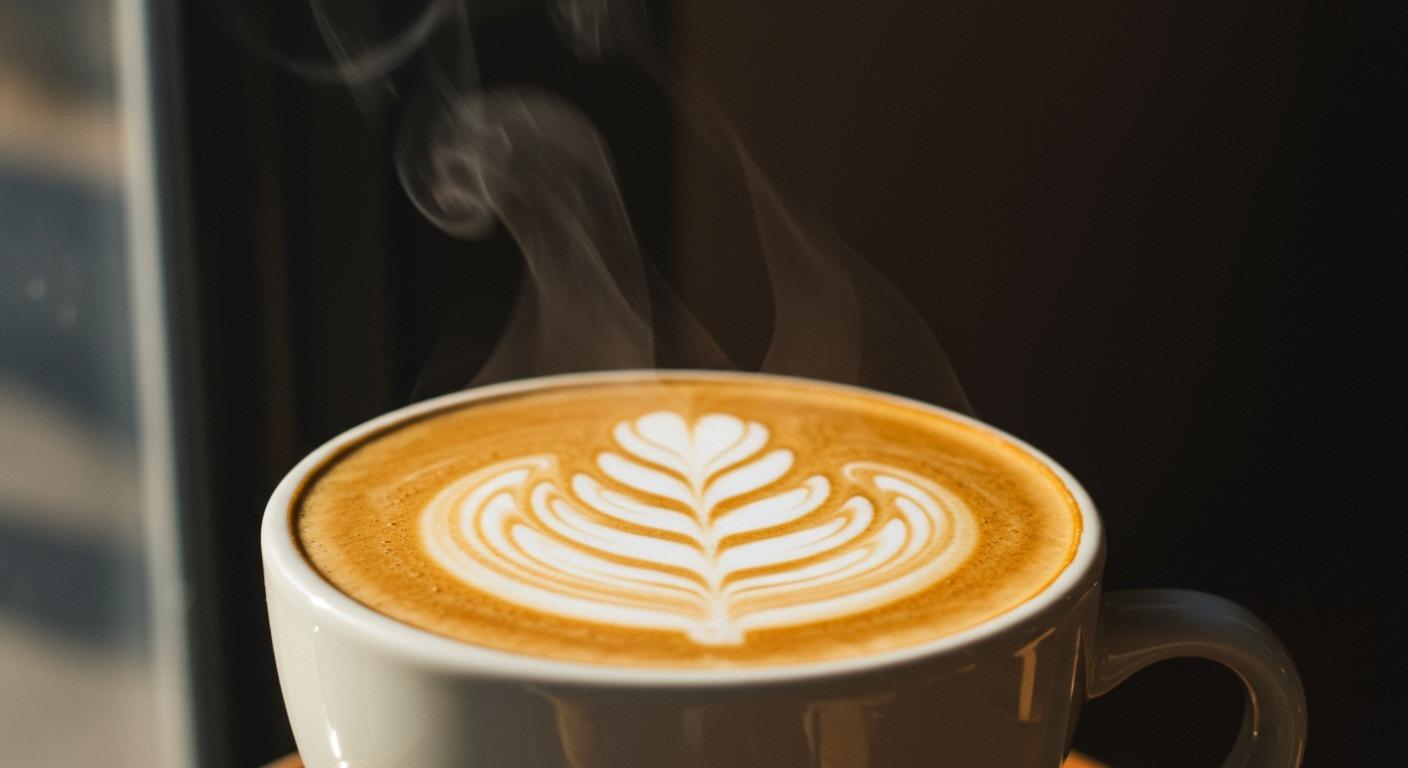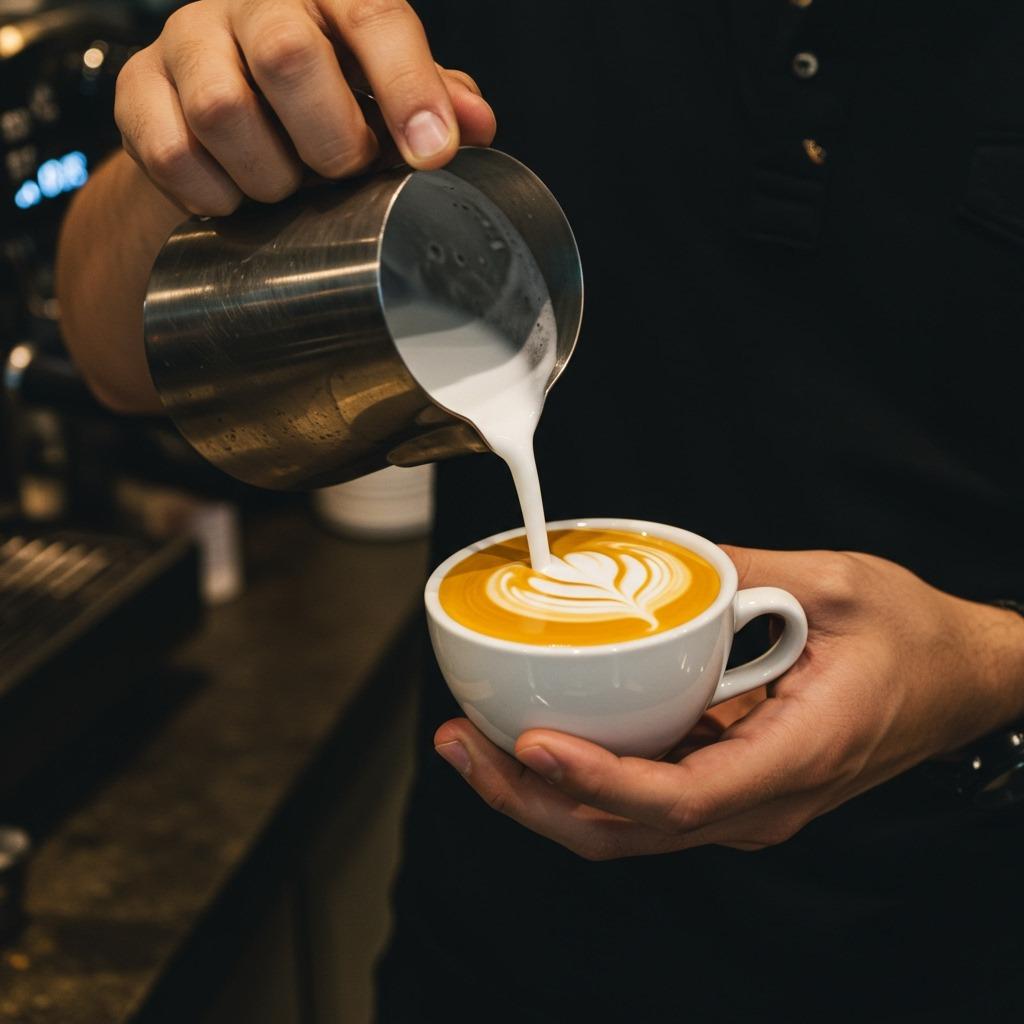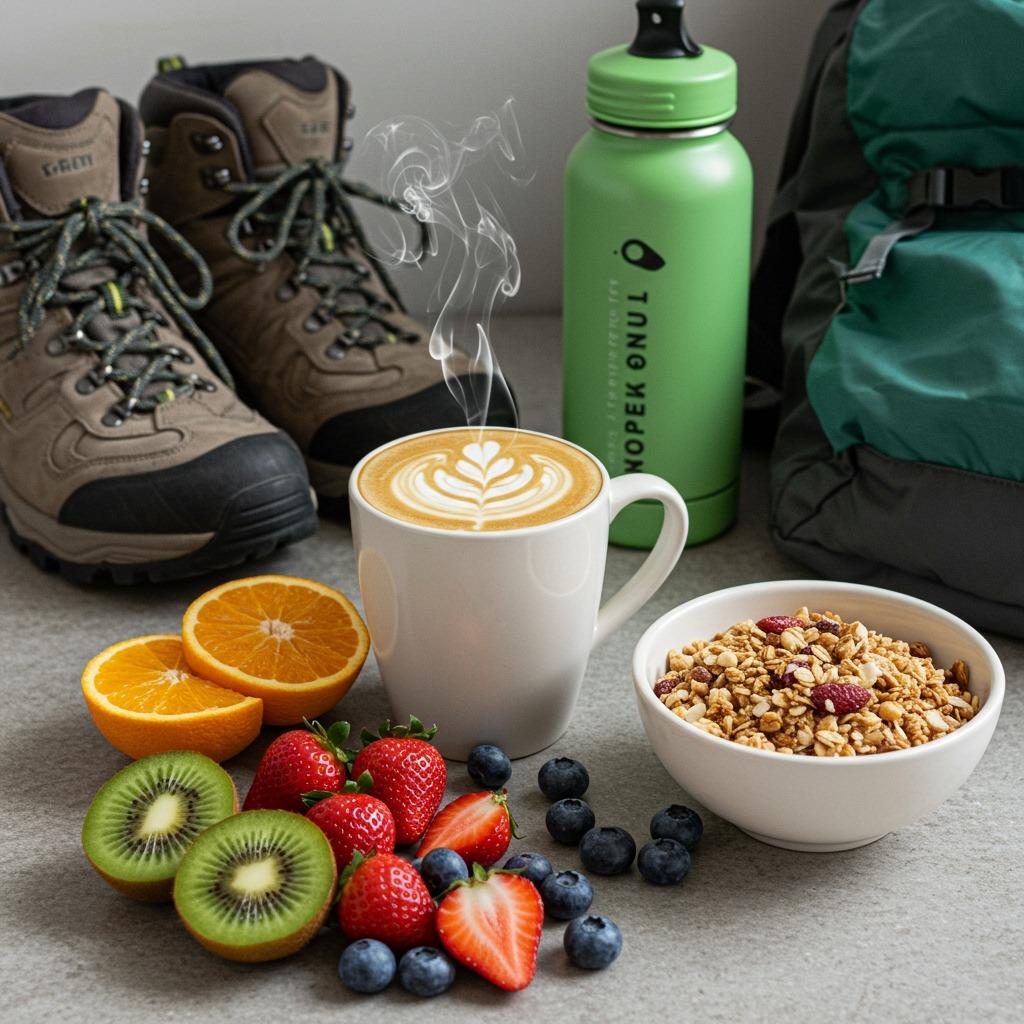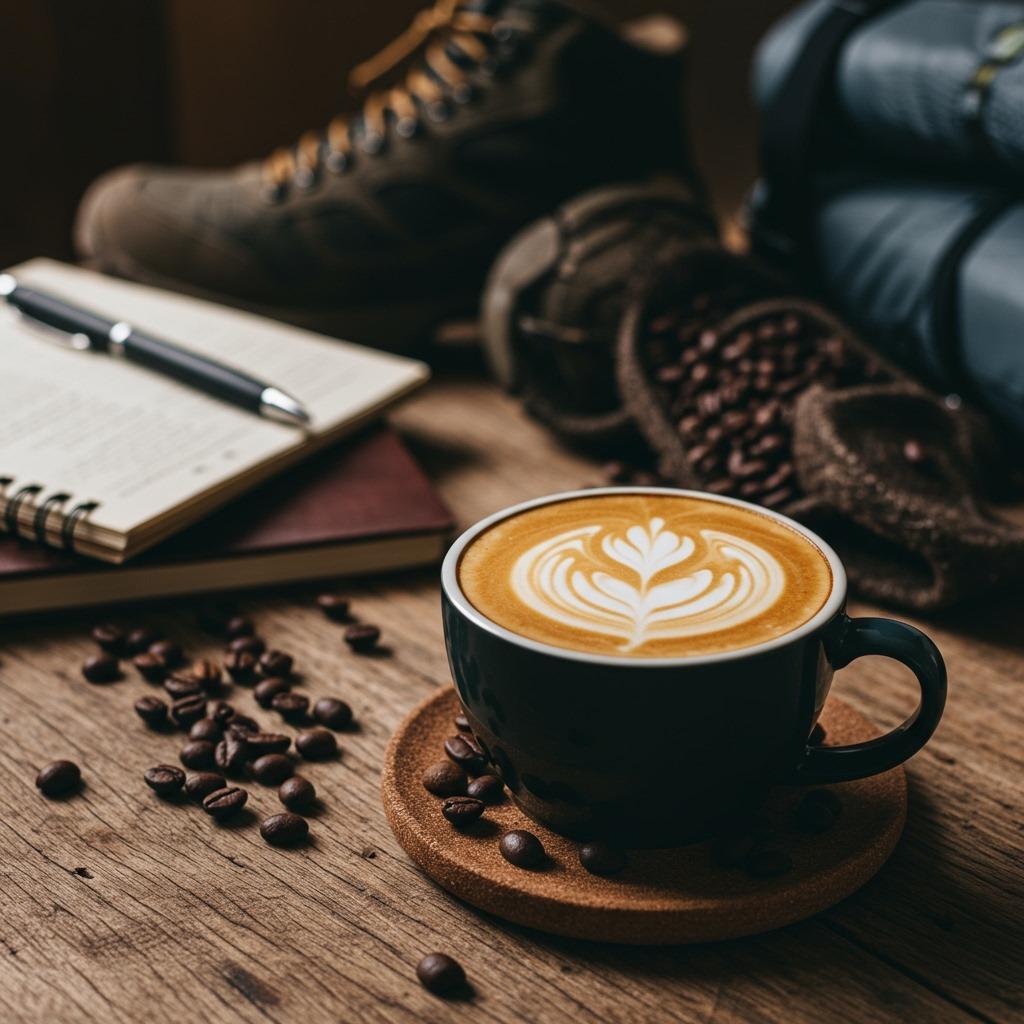Last Saturday morning, sitting in my favorite coffee corner after a long hike, I watched the barista create that perfect layer of creamy foam atop my latte. It struck me how this simple drink has become the gateway to coffee culture for millions of outdoor enthusiasts and casual drinkers alike. Whether you’re refueling after a challenging trail or simply starting your day, understanding what makes a great latte can transform your entire coffee experience.
A latte is one of the world’s most beloved coffee drinks, combining rich espresso with creamy steamed milk to create a perfectly balanced, smooth beverage. Known for its mild coffee flavor and velvety texture, the latte has become a staple in coffee shops worldwide and a favorite among both casual coffee drinkers and enthusiasts.
The word “latte” comes from the Italian term “caffè e latte,” which literally means “coffee and milk.” This simple yet sophisticated drink represents the perfect harmony between bold espresso and silky steamed milk, creating a coffee experience that’s both comforting and energizing. Just like perfecting your camping breakfast ideas, mastering the art of the latte takes practice, patience, and understanding of the fundamentals.

What Makes a Latte Different
A latte consists of three key components that work together to create its signature taste and texture. Understanding these elements helps you appreciate why lattes taste so distinctly different from other coffee beverages.
Essential Ingredients
The foundation of every great latte lies in its carefully balanced ingredients:
Espresso shots (1-2 shots) provide the coffee base and bold flavor that anchors the entire drink. The espresso should be rich, aromatic, and properly extracted to avoid bitterness or sourness. Quality espresso forms the backbone of your latte, much like how good coffee beans are essential for cowboy coffee around the campfire.
Steamed milk (6-8 oz) creates the creamy, smooth body that makes lattes so appealing. The milk should be heated to the perfect temperature while creating microfoam that integrates seamlessly with the espresso. This process requires skill and attention to detail.
Milk foam (thin layer) adds a light, airy finish on top. Unlike cappuccinos with their thick foam caps, lattes feature just a delicate layer that enhances rather than dominates the drink.
The classic ratio for a perfect latte is approximately 1/3 espresso to 2/3 steamed milk, topped with just a thin layer of microfoam. This ratio ensures the espresso flavor shines through while being mellowed by the creamy milk, resulting in a much milder taste than straight espresso.
The Science Behind Perfect Milk Steaming
Creating the ideal latte requires understanding the science of milk steaming. When milk is heated and aerated, proteins and fats undergo changes that create the smooth, creamy texture we love. The key temperature range of 140-160°F allows for optimal flavor development without scorching the milk proteins.
Professional baristas know that the steaming process involves two phases: stretching (introducing air) and polishing (heating while creating a smooth texture). This technique transforms ordinary milk into the silky, sweet foundation that makes lattes irresistible.
How Lattes Are Made: The Complete Process
Creating a latte requires careful technique and attention to timing. Here’s the step-by-step process that transforms simple ingredients into coffee perfection:
Step 1: Prepare the Espresso
Pull fresh espresso shots using finely ground coffee beans. The grind should be fine but not powdery, and the extraction should take 25-30 seconds for optimal flavor. Properly pulled espresso forms a golden-brown crema layer that will integrate beautifully with the steamed milk.
Step 2: Steam the Milk
Heat milk to 140-160°F while creating microfoam with a velvety texture. The steaming wand should be positioned just below the milk’s surface initially, then plunged deeper as the milk heats. This creates the perfect balance of temperature and texture.
Step 3: Combine with Precision
Pour the steamed milk over the espresso, holding back the foam initially. The pouring technique affects both flavor integration and visual appeal. Start from a height to penetrate the crema, then bring the pitcher closer for the finishing touches.
Step 4: Add the Finishing Touch
Top with a thin layer of milk foam for the perfect finish. This final layer should be barely 1/4 inch thick, creating a smooth surface that’s ideal for latte art.
Step 5: Create Latte Art (Optional)
Using the microfoam, create decorative patterns like hearts, leaves, or more complex designs. This artistic element transforms a simple drink into a visual masterpiece that enhances the overall experience.

Latte vs Other Popular Coffee Drinks
Understanding how lattes compare to similar drinks helps clarify what makes them unique and helps you order exactly what you want:
| Drink | Espresso | Steamed Milk | Foam | Typical Size | Strength |
|---|---|---|---|---|---|
| Latte | 1-2 shots | Large amount | Thin layer | 8-12 oz | Mild |
| Cappuccino | 1-2 shots | Equal parts | Thick layer | 5-6 oz | Medium |
| Macchiato | 1-2 shots | Small amount | Minimal | 3-4 oz | Strong |
| Flat White | 2 shots | Medium amount | Microfoam mixed in | 6 oz | Medium-Strong |
| Cortado | 2 shots | Equal parts | No foam | 4-6 oz | Medium |
The key difference lies in the milk-to-coffee ratio. Lattes are much milkier than cappuccinos, making them less intense and more approachable for those who find straight espresso too strong. This makes them perfect for coffee newcomers, similar to how hiking in Texas offers accessible trails for beginners.
Why These Differences Matter
Each variation serves a different purpose and appeals to different taste preferences. Lattes excel as comfort drinks that deliver caffeine without overwhelming coffee intensity. They’re perfect for leisurely sipping, whether you’re planning your next adventure or recovering from yesterday’s hike.
Exploring Milk Options for Your Perfect Latte
The choice of milk significantly impacts a latte’s taste, texture, and nutritional profile. Modern coffee culture has expanded far beyond traditional dairy to include numerous alternatives that can enhance or completely transform your latte experience.
Traditional Dairy Options
Whole milk remains the gold standard for latte creation. Its higher fat content (around 3.25%) creates the richest foam and smoothest texture. The natural sweetness and creamy mouthfeel make it the preferred choice for most professional baristas.
2% reduced-fat milk offers a good middle ground with decent foam capability while reducing calorie content. Many coffee shops use 2% as their standard milk option, providing good steaming properties without excessive richness.
Skim milk produces impressive foam volume due to higher protein concentration, but the resulting texture can feel thin or watery. It’s an excellent choice for those watching calorie intake who still want the visual appeal of traditional lattes.
Heavy cream or half-and-half creates incredibly rich lattes with luxurious texture. While not as common as the primary milk choice, these can be used for special occasion lattes or mixed with other milk types.
Plant-Based Alternatives Revolution
The rise of non-dairy milk alternatives has revolutionized latte options, offering choices for various dietary needs and flavor preferences.
Oat milk has become the superstar of alternative milks for coffee drinks. Its natural sweetness, creamy texture, and excellent steaming properties make it the closest alternative to dairy milk. Many coffee enthusiasts actually prefer oat milk lattes for their subtle sweetness and environmental benefits.
Soy milk was the original non-dairy champion and remains popular for its protein content and relatively neutral flavor. It steams well and creates good foam, though some people detect a slightly beany aftertaste.
Almond milk offers a light, nutty flavor that many enjoy, but it can be challenging to steam properly. Commercial barista versions are formulated to foam better than regular almond milk.
Coconut milk adds tropical notes and works well in flavored lattes. The natural sweetness pairs beautifully with vanilla or caramel syrups, though foam production can be inconsistent.
Hemp milk, rice milk, and pea protein milk represent newer alternatives, each with unique characteristics and varying degrees of steaming success.
Barista-grade versions of plant-based milks often contain stabilizers and proteins that help them steam and foam more like dairy milk, making them excellent choices for home and professional use.
Popular Latte Variations and Seasonal Specialties
Lattes serve as the perfect canvas for creative variations, allowing coffee shops and home brewers to experiment with flavors, spices, and seasonal ingredients.
Classic Flavored Lattes
Vanilla Latte represents the most popular flavored variation. Pure vanilla syrup or extract adds sweetness and aromatic complexity without overwhelming the coffee flavor. It’s an excellent introduction to flavored coffee drinks.
Caramel Latte combines rich, buttery caramel with coffee’s natural nuttiness. Many versions include both caramel syrup mixed into the drink and caramel drizzle on top for visual appeal and extra sweetness.
Hazelnut Latte brings nutty, aromatic flavors that complement espresso beautifully. The combination creates a sophisticated drink that appeals to those who enjoy nutty flavors in their coffee.
Mocha Latte blends chocolate with coffee for the ultimate comfort drink. Using quality cocoa powder or chocolate syrup creates a balanced drink that satisfies both coffee and chocolate cravings.
Seasonal and Holiday Specialties
Pumpkin Spice Latte has become a cultural phenomenon, combining espresso with pumpkin puree and warming spices like cinnamon, nutmeg, and cloves. This fall favorite demonstrates how seasonal ingredients can transform familiar drinks into special occasions.
Peppermint Latte captures winter holiday spirit with cooling mint flavors that create surprising harmony with warm espresso and milk. Often garnished with crushed candy canes or chocolate shavings.
Iced Latte adapts the classic formula for warm weather, using cold milk and serving over ice. The flavor profile changes slightly, with more pronounced espresso notes and refreshing qualities perfect for hot days.
International and Regional Styles
Latte Macchiato reverses the traditional preparation by adding milk first, then pouring espresso on top. This creates distinct layers and a different flavor progression as you drink.
Café au Lait represents the French interpretation, typically using regular drip coffee instead of espresso and equal parts coffee and hot milk. It’s closer to what many Americans might call “coffee with milk.”
Caffè e Latte follows traditional Italian preparation, often served at breakfast and typically consumed quickly rather than sipped slowly like American-style lattes.

The Art and Science of Home Latte Making
Creating café-quality lattes at home has become increasingly accessible thanks to improved equipment and techniques. Understanding the fundamentals allows you to craft personalized drinks that rival professional coffee shops.
Essential Equipment for Home Lattes
Espresso machines range from basic manual models to fully automatic systems. Entry-level machines can produce excellent results with practice, while high-end models offer more control and consistency.
Coffee grinders are crucial for fresh espresso. Burr grinders provide consistent particle size, which directly affects extraction quality and flavor. Investing in a quality grinder often improves results more than upgrading the espresso machine.
Milk pitchers with spouts designed for pouring make steaming and latte art much easier. The pitcher size should match your typical serving quantities.
Tampers ensure even espresso extraction by compressing grounds consistently. Proper tamping technique significantly affects shot quality.
Thermometers help monitor milk temperature until you develop the skill to judge by feel and sound.
Alternative Methods for Budget-Conscious Coffee Lovers
You don’t need expensive equipment to enjoy latte-style drinks at home. Several methods can create satisfying results:
A French press or AeroPress can create concentrated coffee that substitutes for espresso. While not identical, these methods produce strong coffee that works well with steamed milk.
Milk frothers (manual or electric) can create foamed milk without espresso machines. Even a French press can froth milk when used carefully.
Stovetop espresso makers (Moka pots) produce concentrated coffee with more body than drip methods, creating a reasonable espresso substitute.
Instant espresso powder can work in a pinch, though the flavor won’t match fresh espresso. It’s perfect for camping trips where you still want that latte experience, much like when you’re learning how to stay warm while camping.
Mastering Latte Art at Home
Latte art transforms your drink from simple coffee into an impressive creation. While it requires practice, basic designs are achievable for dedicated home baristas.
Heart designs represent the easiest starting point. Begin pouring from height to penetrate the crema, then bring the pitcher close and finish with a quick forward motion.
Leaf or rosetta patterns require steady hand control and proper milk texture. The technique involves side-to-side motions while gradually moving the pitcher forward.
Advanced designs like tulips, swans, or detailed patterns require significant practice but demonstrate true skill mastery.
The key to consistent latte art lies in achieving proper milk texture – glossy, paint-like microfoam that flows smoothly when poured. This skill takes time to develop but dramatically improves the home latte experience.
Health Benefits and Nutritional Considerations
Understanding the nutritional profile of lattes helps you make informed choices about incorporating them into your daily routine, especially if you’re maintaining an active outdoor lifestyle.
Standard Nutritional Profile
A typical 8-oz latte made with whole milk contains approximately:
- Calories: 120-150 (varies by milk type and size)
- Protein: 8-10g (excellent for muscle recovery after hiking)
- Fat: 6-8g (primarily from milk)
- Carbohydrates: 9-12g (natural milk sugars)
- Caffeine: 63-126mg (depending on single or double shot)
- Calcium: 300-400mg (significant portion of daily needs)
Comparing Milk Options
Different milk choices dramatically affect nutritional content:
Whole dairy milk provides complete proteins, vitamins A and D, and significant calcium content. The higher fat content aids in vitamin absorption and provides sustained energy.
Plant-based alternatives vary widely in nutritional content. Soy milk comes closest to dairy’s protein content, while oat milk provides fiber and beta-glucans. Almond milk is lowest in calories but also lowest in protein.
Fortified alternatives often include added vitamins and minerals, sometimes exceeding dairy milk’s nutritional profile in certain areas.
Health Benefits for Active Individuals
Lattes can provide several benefits for outdoor enthusiasts and active individuals:
Protein content supports muscle recovery after physical activity. The combination of caffeine and protein makes lattes excellent post-workout drinks.
Calcium and vitamin D (in dairy versions) support bone health, crucial for activities like hiking and climbing.
Antioxidants from coffee provide cellular protection and may support recovery from exercise-induced stress.
Sustained energy from the combination of caffeine, proteins, and natural sugars can fuel morning activities or afternoon adventures.
Just like choosing the right hiking snacks for sustained energy on the trail, selecting the right latte components can enhance your daily nutrition profile.

Cultural Impact and Global Coffee Evolution
The latte’s journey from Italian breakfast staple to global phenomenon reflects broader changes in coffee culture, urban lifestyle, and social interaction patterns.
Historical Origins and Evolution
Traditional Italian coffee culture centered around quick, intense espresso consumption at bars, typically as part of breakfast routines. The “caffè e latte” was primarily a home breakfast drink, often served in bowls rather than cups.
American coffee culture in the 1980s and 1990s transformed the latte into something entirely different. Larger serving sizes, flavored syrups, and elaborate preparation rituals turned simple coffee and milk into an experience-driven beverage.
The rise of specialty coffee shops created the “third wave” coffee movement, emphasizing quality ingredients, skilled preparation, and artisanal presentation. Lattes became vehicles for showcasing coffee expertise and creativity.
Modern Coffee Shop Culture
Today’s coffee shops serve as social spaces, remote offices, and cultural meeting points. Lattes facilitate longer visits than quick espresso consumption, supporting the business model of modern cafés.
The Instagram-ability of latte art has made these drinks social media favorites, driving demand for visually appealing coffee creations. This phenomenon has elevated barista skills and pushed creative boundaries in coffee presentation.
Global Variations and Adaptations
Different cultures have adapted the basic latte concept to local tastes and ingredients:
Australian flat whites emphasize stronger coffee flavor with less milk foam, reflecting preferences for a more intense coffee taste.
Scandinavian coffee culture often incorporates local milk products and seasonal ingredients, creating unique regional variations.
Asian adaptations might include condensed milk, unique flavoring syrups, or alternative preparation methods that reflect local preferences.
Professional Tips for Perfect Home Lattes
Achieving consistently excellent results at home requires understanding professional techniques and common pitfalls. These insights from experienced baristas can dramatically improve your latte-making success.
Coffee Selection and Preparation
Bean selection matters more than many realize. Medium to medium-dark roasts typically work best for lattes, providing enough flavor intensity to complement milk without becoming overpowering. Single-origin beans can create interesting flavor profiles, while blends offer consistency and balance.
Grinding consistency affects extraction quality more than most home brewers realize. Invest in the best grinder you can afford, and calibrate it properly for your espresso machine. Fresh grinding immediately before brewing makes a noticeable difference in flavor quality.
Extraction timing should fall between 25 and 30 seconds for double shots. Faster extractions often taste sour and underdeveloped, while slower extractions can become bitter and over-extracted.
Advanced Milk Steaming Techniques
Temperature control requires practice to master. Milk should reach 140-160°F – hot enough to enhance sweetness but not so hot that proteins break down and create unpleasant textures.
Texture development happens in two phases: stretching (incorporating air) should occur early in the process, followed by heating and texture refinement. Professional results require mastering both phases.
Pitcher positioning and steam wand technique affect final texture quality. The wand should start near the surface for stretching, then move deeper for heating and polishing.
Troubleshooting Common Problems
Flat, lifeless foam usually results from overheated milk or using milk that’s too old. Fresh, cold milk produces the best results.
Large, bubbly foam indicates too much air incorporation or insufficient texture development. Practice controlling the steaming process, timing, and technique.
Separated or curdled milk suggests overheating or using milk with high acidity. Monitor temperature carefully and use fresh, quality milk.
Weak coffee flavor might require adjusting grind size, increasing coffee dose, or using a darker roast that can stand up to milk dilution.
Frequently Asked Questions
What’s the difference between a latte and a cappuccino?
A latte contains much more steamed milk (2/3 of the drink) with just a thin layer of foam, while a cappuccino has equal parts espresso, steamed milk, and thick foam. Lattes are served in larger cups (8-12 oz) compared to cappuccinos (5-6 oz), making them milkier and milder in coffee flavor.
How much caffeine is in a latte?
A standard latte with one espresso shot contains about 63mg of caffeine, while a double-shot latte has approximately 126mg. This is less than a typical cup of drip coffee (95mg) but provides sustained energy release due to the milk proteins and fats that slow caffeine absorption.
Can you make a latte without an espresso machine?
Yes! Use strong coffee from a French press, AeroPress, or moka pot as your base. Steam milk using a milk frother, the French press method, or even a jar shaken vigorously, then heated. While it won’t be identical to espresso-based lattes, it creates a similar creamy coffee drink that’s perfect for home enjoyment.
What milk works best for lattes?
Whole dairy milk produces the best foam and creamiest texture due to its fat content and protein structure. For non-dairy options, barista-grade oat milk performs closest to dairy milk in terms of steaming properties and flavor integration. The key is using fresh, cold milk regardless of type.
How do you make latte art?
Latte art requires properly textured milk with glossy microfoam that flows like paint. Start pouring from height to penetrate the crema, then bring the pitcher close to the surface while maintaining a steady flow. Simple designs like hearts require practice but are achievable for dedicated home baristas. Focus on milk texture first, then practice pouring techniques.
Can I make lattes ahead of time?
Lattes are best enjoyed immediately after preparation, as the milk texture and temperature degrade quickly. However, you can prepare espresso shots and store them briefly, or pre-steam milk for multiple drinks when entertaining. For make-ahead options, consider cold brew concentrate with cold milk for iced lattes.
Are lattes healthy?
Lattes can be part of a healthy diet when consumed in moderation. They provide protein, calcium, and antioxidants from coffee. The health impact depends largely on milk choice, added sugars, and overall dietary context. For active individuals, the protein and sustained energy can support recovery and performance goals.
Why do some lattes taste different at different coffee shops?
Variations in coffee bean origin, roast level, grind settings, extraction techniques, milk type and steaming methods, water quality, and equipment calibration all affect final flavor. Additionally, barista skill levels and consistency practices vary significantly between establishments, leading to noticeable differences in taste and quality.
Conclusion: Embracing the Latte Lifestyle
The latte’s enduring popularity stems from its perfect balance of coffee flavor and milk creaminess, making it an ideal introduction to espresso-based drinks while remaining sophisticated enough to satisfy serious coffee lovers. Whether you’re refueling after exploring the best hiking dogs on mountain trails or simply starting your morning routine, understanding latte fundamentals enhances every coffee experience.
From its humble Italian origins to global coffee shop staple, the latte represents more than just a beverage—it’s a bridge between cultures, a social facilitator, and an accessible entry point into specialty coffee appreciation. The combination of espresso intensity and milk mellowness creates a drink that adapts to personal preferences while maintaining its essential character.
For those ready to explore beyond basic lattes, the world of specialty coffee offers endless variations and learning opportunities. Consider experimenting with different milk alternatives, seasonal flavors, or even advanced techniques like latte art. Each cup becomes an opportunity to refine your palate and appreciate the craftsmanship behind great coffee.
Whether enjoyed plain or with creative variations, lattes continue to be a cornerstone of modern coffee culture. They provide comfort, energy, and a moment of ritual in our busy lives—much like how primitive camping offers simplicity and connection in our complex world.
Ready to explore more coffee knowledge and outdoor adventures? Check out these helpful resources:
- Master traditional brewing with the National Coffee Association’s comprehensive guides
- Discover specialty coffee techniques at Specialty Coffee Association resources.
- Learn about sustainable coffee practices through the Coffee Research Institute.
The journey from coffee novice to latte enthusiast mirrors many outdoor adventures—it requires patience, practice, and appreciation for both simple pleasures and refined techniques. Every perfectly steamed milk pour and every moment of morning coffee ritual add to the larger story of how we fuel our adventures and connect with the world around us.

